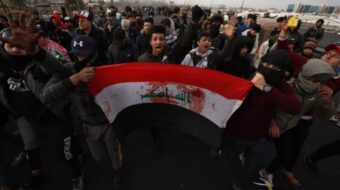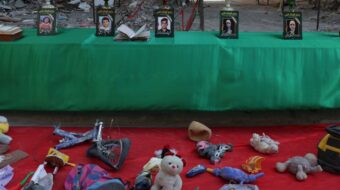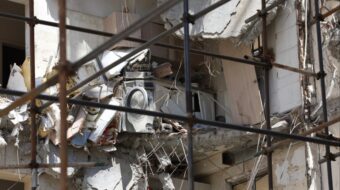On the surface, the recent turmoil in Teheran looks like a case of the clerical elite, led by Supreme Leader Ali Khamenei, slapping down an independent minded President Mahmoud Ahmadinejad, though the battle is couched in vocabulary that does more to obscure than to reveal: accusations of “sorcery” and “witchcraft” get equal billing with charges of corruption and violations of the constitution. But if the language can at times seem odd, the players and the stakes are hardy abstruse.
There is, indeed, a struggle between Ahmadinejad and the clerics around Khamenei, and while it may play out in arguments over obscure religious issues – one critic of the President accused him of recruiting an army of genies – at its heart the fight is over political and economic power: who wields it and to what purpose? Some of the players, like the president and the Supreme Leader, perform in the spotlight. Others, like the powerful Revolutionary Guard and an increasingly restive population hammered by economic difficulties, maneuver in the wings.
The current crisis was sparked off when Ahmadinejad dismissed his Minister of Intelligence, apparently because the latter was tapping his chief-of-staff’s phones and gathering intelligence on the president’s plans for the upcoming round of parliamentary elections in 2012 and the presidential election in 2013. Khamenei forced Ahmadinejad to rehire the minister, which caused the President to boycott cabinet meetings for 11 days, what Iranians are calling the “long sulk.”
What followed were a series of maneuvers by both sides. The president reorganized his cabinet, dropping several ministries, fired the Oil Minister, and put himself in charge. The Majilis, or parliament, claims the act was illegal and, by an overwhelming vote, sent the matter to the Iranian judiciary. No one is talking about impeachment yet, but that straw is in the wind.
There is, indeed, a conflict between Khamenei, the clerics and Ahmadinejad. While not mentioning the Supreme Leader, the president told a Teheran press conference on June 7, “It is very clear now that we are 180 degrees away from them. We are actually on opposite sides.” In a political system dominated by Ayatollahs, it was a bold statement and reflects Ahmadinejad’s judgment that the clerics are no longer all-powerful, and that the Supreme Leader – old and unwell according to most sources – has less authority than the late Grand Ayatollah Ruhollah Khomeini, the first leader of the Islamic Republic.
Presidential confidant and advisor Esfandiar Rahim Mashaei, currently under fire and accused of “deviancy,” once remarked, “The era of sovereignty of religion is over,” and that “An Islamic government is not capable of running a vast and populous country like Iran.” Mashaei, a former intelligence officer in the Revolutionary Guard, has a strong nationalist streak in him-“Iran first” as opposed to “Islam first””-and word is that Ahmadinejad was maneuvering to pass on the presidency to him or another non-cleric in 2013, thus marginalizing the religious establishment.
The clerics are also suspicious that the president’s prediction that the “hidden Iman,” who disappeared in the ninth century AD, would soon emerge was actually an effort to sideline them and shift power to Ahmadinejad’s clique of ultra-nationalist veterans from the 1980-88 war with Iraq.
Certainly, removing a mullah from control of the Oil Ministry would have amounted to a public slap down of a cleric at a time of unprecedented tension between the president and the clerical establishment. While Ahmadinejad was eventually forced to give back the ministry, he ended up appointing an ally, Mohammad Aliabadi, the former head of Iran’s Olympic Committee.
So far, the Revolutionary Guard has come down on the side of Khamenei and have even issued a veiled warning to the President that the Guard might consider releasing records from the disputed 2009 election that saw Ahmadinejad re-elected. However, the Guard is being discreet about how it intervenes, concentrating instead on gathering greater economic power.
The Guard recently acquired control of two large natural gas fields in Fars Province, and its engineering and construction firm, Khatam-ol-Anbia, has become the largest contractor for government projects. The guard also has major interests in mining, telecommunications, dam building and trade. The sanctions leveled at Iran over its nuclear program prevent outside companies from investing, thus allowing the Guard to expand into the energy field. Iran has 150 billion barrels of oil reserves, third largest in the world, and 948 trillion cubic feet of gas, second only to Russia.
According to the Green opposition, the Guard also smuggles goods in and out of Iran to the tune of $12 billion a year.
While the Guard is currently backing Khamenei, according to the trade union activist Homayoun Poorzad, “The Guard is an independent force and not in the pockets of the clerics. They [the Guard] would love to see Ahmadinejad and Khamenei fight it out” while they gather more power.
The sanctions have taken a bite, but the main cause of economic turmoil are the policies of the Ahmadinejad government, which has systematically cut up to $100 billion in yearly subsidies for everything from gasoline, food and water, to education and electricity. Many Iranians see half their paychecks go to pay utility and gas bills.
Coupled with the austerity drive has been the brutal suppression of the trade union movement and the shift from a stabilized workforce to temporary, contract labor. The percentage of workers with benefits has gone from 70 percent of the workforce to 30 percent over the past 15 years. The law provides for unemployment benefits, but only for permanent employees.
While suppression is a major reason for the lack of widespread strike activity, the 14.5 percent unemployment rate also plays a role. “The jobless rate makes it easier to break strikes,” says Poorzad, adding, “Last year was the worst year for the working class since World War II.”
The lack of widespread, organized response is partly due to the government’s repression, including firings, arrests, torture and the occasional execution of leaders. But it is also a testament to Ahmadinejad’s ability to funnel money to the poor. “He is almost a genius,” says Poorzad, “and he is always looking to build his social base and weaken his rivals.” The labor activist says that cutting the subsidies means that “now the President has tens of billions of dollars ” to hand out. It is not clear how long he can continue to do that.
While much of the U.S. media has begun to write off Ahmadinejad, “I don’t see him as being on the ropes,” says Jamie Webster, a consultant for PFC Energy.
But the economic situation is inherently unstable. So far the government has managed to keep unrest under control by cash outlays and forcing the merchant class – many of whom support the Green opposition – to keep prices artificially low. This forces many merchants to operate at a loss. “Eventually prices will have to be allowed to float,” says Poorzad, “and when that happens inflation will go up sharply.”
The “Greens” opposed Ahmedinejad in the 2009 elections and mobilized hundreds of thousands of people to protest what they charged was widespread fraud in the outcome.
Will the situation explode?
According to Poorzad, the trade union movement is just trying to keep its head above water. “Unions are facing the worst repression in many years,” he says, “we are just trying to stay out of prison. It is very dangerous.”
So far, the government has managed to drive a wedge between the more affluent and middle-class Green opposition and the urban and rural poor. But if the economy worsens and living standards continue to plummet, that wedge may give way, as it did in 2009, when the urban working-class made common cause with Teheran’s middle class. Ultimately, “things are going to get out of hand,” says Poorzad.
It is important to remember that Iran is the only country in the Middle East that changed its ruling class through mass demonstrations. It may end up that Egypt and Tunisia will do so as well, but so far both countries have simply deposed their rulers.
Iran’s government has enormous repressive powers at its fingertips, from the million-member Basij militia to the powerful Revolutionary Guard and the secret police. But its centers of power are hardly united, and it harbors a large population with a memory of what it accomplished in 1979 by taking to the streets.
This article originally appeared in Dispatches from the Edge.










